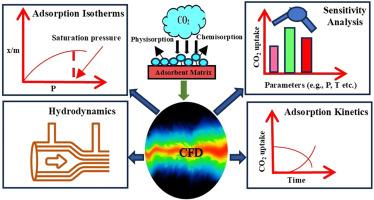Review on computational fluid dynamics (CFD) modeling and simulation of CO2 adsorption
IF 7.9
Q1 ENGINEERING, MULTIDISCIPLINARY
引用次数: 0
Abstract
The increasing emission of carbon dioxide (CO2) into the environment has a significant influence on increasing global warming. The widely used carbon capture technologies (CCTs), including adsorption, absorption, cryogenics and membrane separation, have been reported previously through both experimental and simulation studies. Simulation studies are particularly considered essential tools for investigating the performance of the process from various aspects, as well as for predicting the complex behavior in any real system without actual experimental setups. This review mainly focuses on the recent advancements in computational fluid dynamics (CFD), modeling and simulation as a transformative tool for optimizing CO2 adsorption processes. The fundamentals of CFD with their role in accurately simulating complex phenomena involved in the CO2 adsorption are discussed. Parametric sensitivity analysis, hydrodynamics, kinetic and adsorption isotherms are thoroughly studied, and critical challenges, including mesh independence, model complexity, and scalability, are also addressed. The future research directions proposed include the integration of CFD with machine learning algorithms, the development of multi-scale models, and the deployment of CFD methodologies to industrial-scale applications.

CO2吸附计算流体动力学(CFD)建模与仿真研究进展
二氧化碳(CO2)排放到环境中的增加对全球变暖的加剧具有重要影响。目前广泛应用的碳捕集技术包括吸附、吸收、低温和膜分离等,已有实验和模拟研究报道。模拟研究被认为是从各个方面研究过程性能的重要工具,也被认为是在没有实际实验设置的情况下预测任何真实系统的复杂行为的重要工具。本文主要综述了计算流体动力学(CFD)、建模和仿真作为优化CO2吸附过程的变革性工具的最新进展。讨论了CFD的基本原理及其在精确模拟二氧化碳吸附过程中所起的作用。对参数敏感性分析、流体动力学、动力学和吸附等温线进行了深入研究,并解决了网格独立性、模型复杂性和可扩展性等关键挑战。未来的研究方向包括CFD与机器学习算法的集成、多尺度模型的开发以及CFD方法在工业规模应用中的应用。
本文章由计算机程序翻译,如有差异,请以英文原文为准。
求助全文
约1分钟内获得全文
求助全文
来源期刊

Results in Engineering
Engineering-Engineering (all)
CiteScore
5.80
自引率
34.00%
发文量
441
审稿时长
47 days
 求助内容:
求助内容: 应助结果提醒方式:
应助结果提醒方式:


